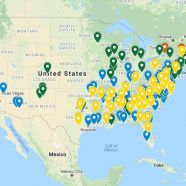Interview
South Writ Large interviewed Dr. Hilary N. Green of The University of Alabama about her extensive work on The Confederate Monument Removal, 2015–2020: A Mapping Project.
Tell us about your new project documenting the removal of monuments in the United States. What prompted you to embark upon this research?
The Confederate Monument Removal, 2015–2020: A Mapping Project is an attempt to document the removal of Confederate monuments and memorials from the public landscape and provide accurate data to inform contemporary debates. Following the murder of George Floyd, the sheer number and speed of removals was striking. More monuments and memorials have been removed and in a shorter period of time than those removed following both the 2015 Charleston massacre and 2017 Charlottesville Unite the Right rally combined. This phase also has seen the removal of monuments for enslavers, settler colonists, segregationists, and other white supremacists across the United States and world. Yet, I noticed that most news media outlets either underreported the numbers or promoted false narratives on the processes contributing to this phenomenon. As a scholar, I wanted to provide some order to the rapidly changing landscape and document it in a visible way for my own teaching and research. I knew that this topic would be discussed in many classrooms and venues. So I intentionally designed a simple public resource for educators, scholars, activists, and public officials.
What types of monuments does your database track? Plaques? Statues? Other structures?
I am tracking monuments, memorials, plaques, public buildings and venues, and buildings at institutions of higher learning. I am not tracking K–12 schools and mascots, street names, or fellowships/scholarships.
When does your database begin tracking monument removal?
While I do include some pre–Charleston massacre removals, the mapping project focuses on the monuments removed since Charleston, Charlottesville, and now George Floyd. This five-year period had been an interesting development in terms of the history of Confederate monuments. Previous removals had occurred without fanfare and as the result of progress and gentrification. Monuments are still being added. These additions are not merely relocated monuments, such as the University of Mississippi monument placed in an enlarged campus cemetery location. The aftermaths of Charleston, Charlottesville and George Floyd have not stopped the placement of over 20 new plaques, monuments and battle flags on both public and private property. This period represents a widespread rejection of the Confederate commemorative landscape and the massive deletion of monuments instead of additions.
What trends do you notice in terms of monument removal? Are there regional or temporal patterns?
There are three distinct phases of removal. Each phase has been marked by a violent event in the following cities: Charleston, Charlottesville, and Minneapolis. The majority of the removals have occurred peacefully and following a clear process: public officials hold hearings, vote, and remove after a designated period of a week to 45 days on average. In terms of non-Confederate monuments, Christopher Columbus and Edward Colston have been the most targeted individuals and, prompted by protests, these monuments have been toppled globally. Backlash has occurred with the toppling (and quick replacement) of a Frederick Douglass statue and the toppling of two federal Civil War monuments. These examples have been noted. Temporally, this is a global movement. In the United States, North Carolina and Virginia have seen the most removals thus far.
Does your database track the construction of new monuments or where fallen monuments end up?
The construction of new monuments is not included in this database. If a monument is relocated to a new location (museum, cemetery, or storage), I try to note that in the entry, but it is not tracked. For instance, an African American museum now owns a removed Confederate monument and plans to provide an interpretative framework for it for museum-goers in Houston. This would make for another great project for students and scholars.
How do you plan to use your data? For a new writing project or a new map?
Great question. I have and continue to plan to use the data for conference presentations and teaching. I also have a few short writing pieces where I have drawn on the data for my evidence. Overall, the mapping project has been very helpful in advancing my own scholarship.
What do you imagine as the future of monuments in U.S. life?
Great question. Confederate monuments will continue to be removed from the American landscape. More communities are rejecting the white supremacist logics imbued by the original monument builders and are embracing the diversity of current community members. In terms of new monuments, I think that the great man and woman monument style is over. Abstract design and group design (i.e., Women’s Rights Pioneers in Central Park, NYC) will become the norm. As a result of the success of the National Memorial for Peace and Justice, monuments and memorials for difficult histories of lynching, genocide, and other racial events will be placed in the landscape as a way to acknowledge and repair past wrongs.







